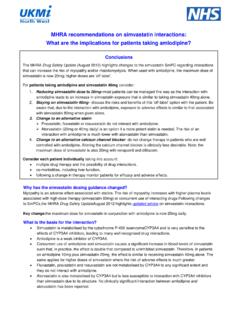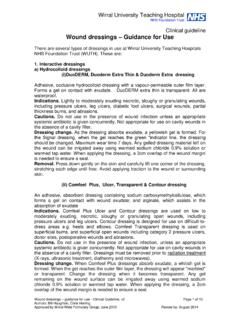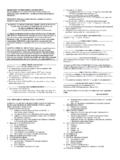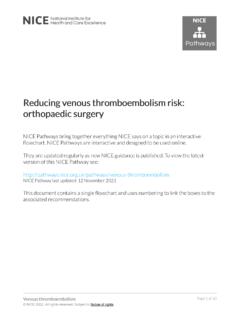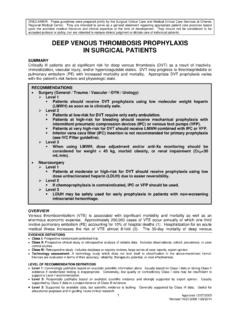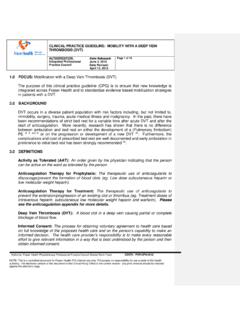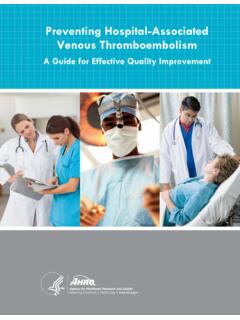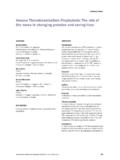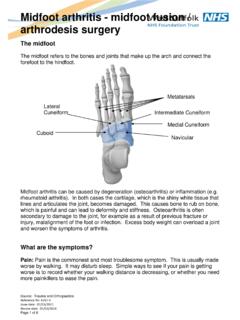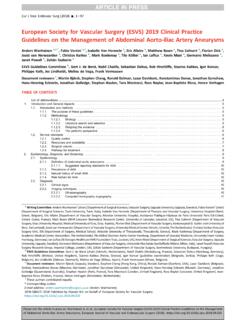Transcription of VTE prophylaxis Trauma and Orthopaedics
1 Venothromboembolism prophylaxis : Trauma and Orthopaedics Clinical guideline, Principal author: Nigel Donnachie Approved by MCGT August 2014 Review date: February 2015 Page 1 of 10 Clinical Guideline Venothromboembolism prophylaxis : Trauma and Orthopaedics venous thromboembolism (VTE) is a recognised complication associated with inactivity and surgical procedures. Therefore, all patients undergoing orthopaedic elective or Trauma surgery should be assessed to establish their risk factors for developing VTE and an agreed treatment regimen should be implemented. NOTE: These guidelines are not intended to cover patients who are already admitted on warfarin therapy or those suspected of suffering from a thromboembolic event.
2 These are guidelines only and can be deviated from if it is thought to be in the patient s best interest. 1. Completing risk assessments VTE assessments should be completed using the electronic VTE assessment pathway that is accessed from the electronic patient record system (PCIS). These assessments require the identification of the following risk factors for thrombosis and bleeding. thrombosis Risk Factors a) Active cancer or cancer treatment 2pts b) Age >60yrs 1pt c) Dehydration 1pt d) Known Thrombophilias / Hypercoagulation state 4pts (eg, Protein C or S or AT III deficiency, Factor V Leiden, Lupus anticoagulant, Prothrombin gene mutation) e) Obesity (BMI > 30 kg/m2) 1pt f) One or more significant medical comorbidities 1pt (eg, Heart Disease, metabolic, endocrine or respiratory pathologies, acute infectious diseases, inflammatory conditions) g) Previous personal history of DVT/PE (requiring warfarinisation) 4pts < 5yrs ago h) Previous personal history of DVT/PE (requiring warfarinisation)
3 3pts > 5yrs ago or first degree relative with a history of DVT/PE h) Varicose veins with phlebitis 1pts i) Significantly reduced mobility for 3 days or more 2pts j) Acute surgical admission with inflammatory or 1pt Intra-abdominal condition k) Critical Care admission 2pts l) Use of hormone replacement therapy 2pts m) Use of oestrogen -containing contraceptive therapy 2pts n) Pregnancy or <6weeks post partum Not part of scoring (see NICE guidance for specific risk factors) system, seek specialist advice on thromboprophylaxis Risk category calculated by electronic VTE assessment pathway 0 2 3 4 or More LOW MODERATE HIGH Venothromboembolism prophylaxis : Trauma and Orthopaedics Clinical guideline, Principal author: Nigel Donnachie Approved by MCGT August 2014 Review date.
4 February 2015 Page 2 of 10 Bleeding Risk Factors a) Active bleeding b) Acquired bleeding disorders (such as acute liver failure) c) Concurrent use of anticoagulants known to increase the risk of bleeding (such as warfarin with INR >2) d) Acute stroke e) Thrombocytopaenia (platelets<75x109/L) f) Uncontrolled systolic hypertension (230/120mmHg or higher) g) Untreated inherited bleeding disorders (such as haemophilia and von Willebrand s disease) h) Neurosurgery, spinal surgery or eye surgery i) Other procedure with high bleeding risk j) Lumbar puncture/epidural/spinal anaesthesia expected within the next 12 hours k) Lumbar puncture/epidural/spinal anaesthesia within the previous 4 hours l) No identified bleeding risk 2.
5 Treatment recommendations Once the assessment form has been completed, the system will recommend a treatment based on the procedure/operation being carried out and the patient s thrombosis risk factor. NOTE: If any bleeding risks are present, it is for clinical staff to decide whether the risk is sufficient to preclude pharmacological intervention. The treatments recommended are based on the tables in Appendix 1. Treatment recommendations are based on each patient s renal function, which is estimated using the Cockcroft & Gault equation (see Appendix 2). Patients taking antiplatelets/anticoagulants For major, elective lower-limb orthopaedic surgery, aspirin and clopidogrel are usually terminated 7 14 days prior to surgery (as advised during preoperative assessment).
6 These treatments can be recommenced once perioperative anticoagulation treatment is terminated (ie, the day after enoxaparin or rivaroxaban are discontinued). In specific cases, this regimen may be deviated from depending on specific medical needs (eg, cardiac status). Patients who are taking warfarin require an individualised VTE regimen this should be determined by the orthopaedic consultant managing their care. Two-stage revision arthroplasty Two-stage revision arthroplasty surgery requires consideration of enoxaparin therapy after the first stage, followed by enoxaparin OR rivaroxaban after the second stage (unless contraindicated). The exact regimen needs to be agreed perioperatively by the surgical team.
7 Extended duration enoxaparin treatment Hip fracture patients who have extended enoxaparin therapy prescribed post discharge should have their platelet counts and potassium levels monitored approximately one week post discharge and at weekly intervals thereafter to exclude potassium imbalance and heparin-induced thrombocytopenia. Venothromboembolism prophylaxis : Trauma and Orthopaedics Clinical guideline, Principal author: Nigel Donnachie Approved by MCGT August 2014 Review date: February 2015 Page 3 of 10 3. Anti-embolism stockings All inpatients are to be offered bilateral above knee anti-embolism stockings on admission to hospital.
8 However, depending on surgical/injury site then unilateral or below knee stockings may be indicated. The following should be considered: For patients undergoing upper limb surgery, stockings should be applied to both legs before surgery. If lower limb surgery is being undertaken, a stocking should be applied to the non-operative leg prior to surgery. Where possible, a stocking (above or below knee) should be applied to the operative leg as soon as possible after surgery Stockings should be worn until the patient returns to their normal level of mobility. If a patient has diabetic neuropathy or severe peripheral vascular disease, stockings should NOT be applied this should be documented in the patient s medical notes If above knee stockings are causing concerns regarding patient compliance or correct fit, below knee stockings can be used.
9 If a patient s risk/operative risk assessment advises enoxaparin or rivaroxaban therapy but the patient has a bleeding risk sufficient to preclude pharmacological intervention, foot compression pumps should also be prescribed. These are available from the Trauma Unit. 4. Auditing patient outcomes and compliance with guidelines The Directorate VTE policy is currently being audited with regards to the side effects and success rate of the prophylaxis . Please inform Mr. Donnachie s Secretary (by telephone, Ex: 4303 or in writing) of any complications that may be partly or wholly attributable to the prophylaxis given (ie, wound haematoma, gastric bleeding, etc) or failure of prophylaxis (ie, proven DVT/PE) within 3 months of surgery.
10 References venous thromboembolism: reducing the risk of venous thromboembolism ( deep vein thrombosis and pulmonary embolism) in inpatients undergoing surgery. NICE clinical guideline 46 (April 2007). Rivaroxaban for the prevention of venous thromboembolism after total hip or total knee replacement in adults. NICE Technology Appraisal guidance no. 170 April 2009. Rivaroxaban (Xarelto ) 10mg film-coated tablets. Summary of Product Characteristics. Bayer plc. (Last revision of text November 2013). Cockcroft DW, Gault MH. (1976) Prediction of creatinine clearance from serum creatinine. Nephron; 16: 31 41. Venothromboembolism prophylaxis : Trauma and Orthopaedics Clinical guideline, Principal author: Nigel Donnachie Approved by MCGT August 2014 Review date: February 2015 Page 4 of 10 Appendix 1 : Treatment guidelines Risk assessment chart Trauma Trauma injury Treatment guidelines Low risk Moderate risk High risk HIP FRACTURE Enoxaparin 20mg nocte commencing night of admission and continuing until post-operation, at that point increasing to 40mg* nocte for 28 days.




